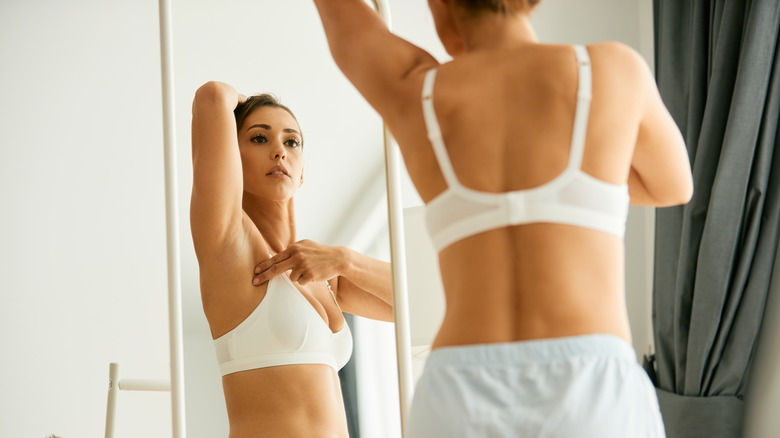How To Do A Self Breast Exam
Denzel Washington said in "Training Day", "To protect the sheep, you got to catch the wolf. And it takes a wolf to catch a wolf."
Women and wolves have many parallels, according to Dr. Clarissa Pinkola Estés, author of Women Who Run With The Wolves. She describes both as curious, intuitive, protective, and endowed with great strength (per The New York Times). As wolf-like women, Denzel reminds us that we are capable of catching other, more nefarious beasts — like breast cancer, for example.
While the National Breast Cancer Foundation notes that breast cancer can't be prevented, the key to beating it lies in early detection. They explain that when coupled with adherence to guideline-recommended mammography, breast self-exams are invaluable in maintaining breast health – arming women with the important knowledge of what their breasts typically look and feel like, so that any new developments can be communicated to their doctors right away.
When should breast self-exams be done?
One in eight women in the United States alone will develop breast cancer (per American Cancer Society). Breast cancer occurs mostly in middle-aged and older women, with only a small number of women developing it before the age of 45. For that reason, the U.S. Preventative Services Task Force recommends that women begin getting mammograms at the age of 50 and return for regular screenings every two years. According to the American College of Radiology, mammography has reduced the mortality rates associated with breast cancer by 40% since 1990.
But despite the current guidelines for mammography, your breast cancer awareness journey shouldn't begin at 50. The University of Maryland Medical System explains that women should start performing breast self-exams around the age of 20 and continue the practice throughout their lifetimes. The best practice is to do it every month, a few days after the start of your period to avoid menstrual-related swelling and tenderness. For women who no longer have a period, it's recommended that you pick a date — like the first Saturday of the month, for example, and do it every 30 days.
How to do a visual breast exam
When you give yourself a breast self-exam, you'll want to kick it off with a visual examination. Mayo Clinic suggests standing shirtless (and braless) in front of a mirror large enough to see your breast clearly. Facing forward with your arms down by your sides, begin looking for any visible changes. Is there any change in size, shape, color, or symmetry? Does the skin on your breasts show signs of puckering or dimpling? Take a closer look at the nipples, as well. Has one become inverted or is there any discharge?
After you've got a good lay of the land, put your hands on your hips, lean forward a bit, and give it another good look, looking for all the same things. After that, raise your hands over your head, and inspect again. Keep an eye out for any signs of swelling, redness, or rashes (via BreastCancer.org).
Get a little handsy
Once you've finished checking yourself out in the mirror, it's time to get a little more hands-on. Find a flat surface to lie down on, like your bed or a yoga mat on the floor. Mayo Clinic recommends laying down so that the breast tissue spreads out and becomes thinner and easier to examine. You could use a little lotion on your fingers if you prefer so that they slide over the skin with ease.
Before you begin, decide on a pattern you would like to use to ensure that you cover the entire surface of each breast. The University of Maryland Medical System recommends using lines or circles. If you prefer lines, raise your opposite arm, place the pads of your middle three fingers in the armpit and, pressing firmly, begin moving them methodically down until they're just below the breast. Slide your fingers just slightly closer to your middle and work your way back up, continuing until you've covered the entire breast, making sure you go all the way up to your collarbones.
If circles are more your thing, begin at the outer edge of the breast and slide your fingers around its entire circumference. Do that over again in smaller circles until you reach the nipple. With this method, make sure you go back and check around the collarbones and the armpits. Be sure to use different levels of pressure so that you can get deeper into the tissue.
What's normal and what you should report
If you happen to feel a lump in your breast during your self-exam, don't panic! The breast feels different in different areas, and sometimes lumps can occur during certain parts of your menstrual cycle, according to the Mayo Clinic. Our breasts are also subject to change in look and feel as we age, so Breastcancer.org suggests keeping a journal and making notes each time you perform a self-exam. If any changes last more than one menstrual cycle or seem to grow, be sure to call your doctor right away.
If you notice any signs of redness, warmth, rash, discoloration, puckering, or dimpling on the skin, it's also best to call your doctor for an appointment (per Cleveland Clinic). Hard knots and thick spots in the breast tissue should also be reported, as well as any nipple discharge, or pain that won't go away.
What to expect at your follow-up appointment
If you set up an appointment with your doctor after finding something unusual during your own breast exam, there are a few things you can expect according to Breastcancer.org. After taking stock of your medical history, your doctor will likely perform their own physical exam. After that, imaging testing might be offered to you. For women under 30, or who are pregnant or nursing, you can expect that they'll use an ultrasound machine. Both an ultrasound and a mammogram are typically used for women over 30. Additional testing may come in the form of magnetic resonance imaging (MRI), molecular breast imaging (MBI), or biopsy testing.
Don't be shy about asking your doctor as many questions as you need to until you've got all the answers and all of your concerns have been addressed. If you don't feel comfortable with your doctor's response after your appointment or you still have worries, it's perfectly normal to seek out a second opinion,
And as always, keep calm and protect your breasts. You're a wolf, remember? You've got this.






